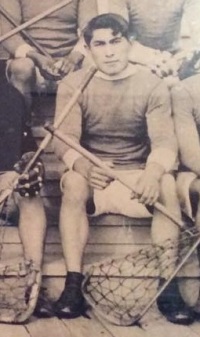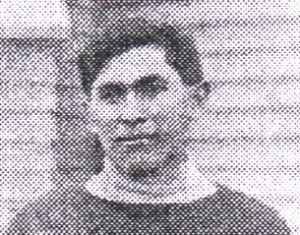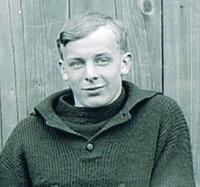
ANDREW JACK
(birth and death dates unknown)
Vancouver Terminals (1923-1924)
Andrew Jack, a member of the Skwxwú7mesh (Squamish) Nation, was the second aboriginal player ever to play professional lacrosse in British Columbia when he became the goalkeeper for the Vancouver Terminals in the final weeks of the 1923 season.
Replacing five-year veteran Jake Davis between the posts, Andrew Jack – or “Jacks”, as the press erroneously referred to him – appeared in Vancouver’s last two matches of 1923. He helped lead the Terminals to 9-8 and 10-2 victories as Vancouver finished up with a 7-9 win-loss record versus the champion New Westminster Salmonbellies.
“Jacks Puts Indian Sign On Royal Scorers” proclaimed the Vancouver Daily Province in the leading sports story after the 10-2 rout of the New Westminster Salmonbellies (who were sometimes also nicknamed the Royals on account of New Westminster being known as the Royal City).
With the reporter stating Vancouver had “…not played better lacrosse in years”, primary credit was given to the rookie Squamish goalkeeper. The Terminals had been suffering some morale problems on and off the field in previous weeks, and Andrew Jack’s play that afternoon was just the tonic required by players and fans to get over that slump.
In the typical reporting style and language of the day, “A swarthy redskin, whose forebearers may have swung a mean tomahawk in tribal wars swung a meaner lacrosse stick on Saturday and proved to be the undoing of the Redshirts at Athletic Park.”
“Whatever branch of sportive endeavor his ancestors may have pursued, they assuredly never worked to greater advantage than their copper-coloured descendant did when he stepped into goal for the troubled Vancouver lacrosse team and halted every shot but two in a torrent of sharp-shooting launched by the Salmonbellies when they saw the game slowly but surely slipping away.”

While reporters from that era saw nothing wrong in exploiting and embellishing the ‘savage Indian’ motif to spice up their articles, it is also clear that the media and fans back then were also genuinely enthusiastic and excited about the addition of Andrew Jack and his fellow Squamish team-mate Louie Lewis to the Vancouver roster. Regardless of skin colour and the prejudices of the day, anyone leading Vancouver to an embarrassing result over the hated Salmonbellies would have quickly won over many admirers in the Terminal City.
Con Jones re-signed him as the Vancouver Terminals goalkeeper for the 1924 season.
Despite his minutely short professional career, just 6 games played before pro lacrosse died suddenly, Andrew Jack clearly held his own against the world’s best with a 3-2-1 record and a fairly impressive 5.33 goals against – allowing a total of 10 goals in 1923 and 22 goals in 1924.
Prior to joining the Vancouver Terminals in September 1923, he played for the North Vancouver-based Squamish Indians senior teams managed by the legendary Andy Paull. In 1922 the ILA Squamish Indians won the Vancouver City Senior League championship with a 12-1-2 record.
(PHOTO SOURCE: courtesy of Carol Joseph and Gail Lewis family collection)





You must be logged in to post a comment.